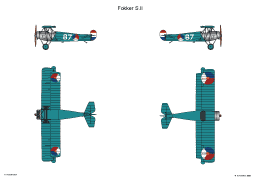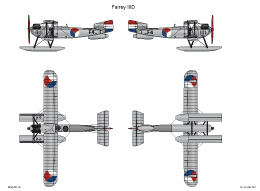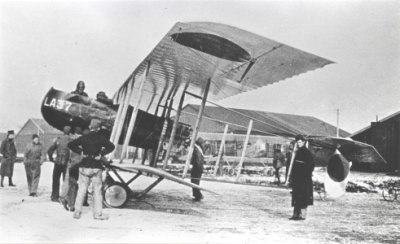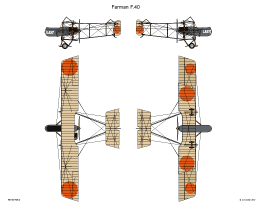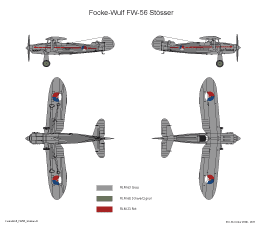- Details
- Hits: 8240
History
Early twenties (of the twentieth century) this trainer was developed by Fokker. Interestingly, the student and the instructor sat next to each other.
| Dimensions: | |||
| Wingspan: | 11,22m | Length: | 7,20m |
| Height: | - m | Wing area: | - m2 |
| Weights: | |||
| Empty weight: | 818 kg | Max. start weight: | 1202 kg |
| Performances: | |||
| Max. speed: | 145 km/u | Rate of climb: | - m/min |
| Range: | 300 km | Service ceiling: | 4500 m |
| Miscellaneous: | |||
| Engine type: | One Thulin G rated 110 - 125 hp; From 1925: one Le Rhône-Oberursel rated 110 hp. | ||
| Crew: | Two men: one instructor plus one pupil | ||
| Armament: | None | ||
Information about Dutch aircraft.
| Serials
Serials
| Constr. nr.
Constr. nr.
| Date in service
Date in service
| Date out of service
Date out of service
| Notes
notes
|
|---|---|---|---|---|
| 84 | ||||
| 85 | ||||
| 86 | ||||
| 87 | ||||
| 88 | ||||
| 89 | ||||
| 90 | ||||
| 91 | ||||
| 92 | ||||
| 93 | ||||
| 94 | ||||
| 95 | ||||
| 96 | ||||
| 97 | ||||
| 98 |
1/72nd Scale
Kits
- Omega
- Set 72191: a resin kit with decals for a Dutch aircraft
Modelling add-on
- Aeroclub
- Set E015: 9 cyl. Le Rhone 110hp Rotary (Diverse WW1)
- Airwaves
- Set SC7289: WW1 Le Rhone 9cyl 110hp
Decals
- --
- Set --: ---.
1/48th Scale
Kits
- --
- Kit --: --
Modelling add-on
- --
- Set --: --
Decals
- --
- Set --: --
The colour of the machines is not entirely certain.
I consider that they were most likely painted LVA blue.
However on the few photos I've seen, it seems the colour is somewhat darker though.
Some state that they were overall LVA khaki, a colour such as applied on the Fokker D.VII and Fokker C.I was applied. This colour is considerably darker than that of e.g. the Fokker S.IV.
| Scheme | Colour name | FS-number | WEM | Humbrol | XtraColor | Vallejo Model Color | Vallejo Model Air | |
|---|---|---|---|---|---|---|---|---|
| Standard #1 | Overall | LVA Blue | AC D05 | 115 ? | X-214? | |||
Check www.paint4models.com for an extensive conversion table with lots of colour and paint systems.
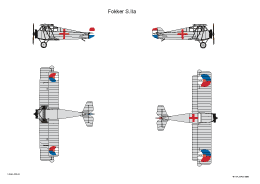
Shown above left is the early version. At the right the later, final version.
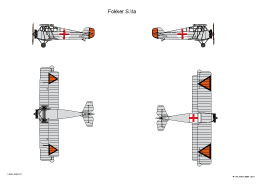
Location and dimension of triangles on the wings is unknown
Literature.
| Cockpit, nummer 10, oktober 1971 jaargang 12, oktober 1971: 'Vliegtuigen uit onze Luchtmacht' De Fokker S-IIA | Hugo Hooftman | Pag. 272 - 275 | 1971 | COCKPIT-uitgeverij, Bennekom |
| Nederlandse Militaire Luchtvaart in Beeld. deel 1. | Hugo Hooftman | Pag. 86 - 89 | 1977 | Uitgever: Europese Bibliotheek, Zaltbommel |
| Fokker, Bouwer aan de wereldluchtvaart | Thijs Postma | Pag. 56 | 1979 | Uitgever: Unieboek b.v., Houten |
| De Nederlandse Vliegtuigen: Alle vliegtuigen ooit in Nederland ontworpen en gebouwd | Theo Wesselink & Thijs Postma | Pag. 26 | 1982 | Uitgever: Romen Luchtvaart, Haarlem |
| KLu Vliegtuigen: De vliegtuigen van de Koninklijke Luchtmacht vanaf 1913 | Wim Schoenmaker & Thijs Postma | Pag. 38 | 1987 | Uitgeverij De Alk, Alkmaar |
| Camouflage en Kentekens | J.Greuter e.a. | 1997 | Bonneville – Bergen (NH) |
Websites.
Thanks to H. Berfelo for providing me with information regarding the drawings and colours.
- Details
- Hits: 10413
History
The Fairey III, was designed as Fairey N.10 because of an specification of the RNAS in 1917 for carrier aircraft. It was an two seat biplane on floats, equipped with folding wings and a 260 hp Sunbeam Maori engine. It made its maiden flight in September 1917.
Further test followed with both a float version as a land version.
Soon an order for 50 examples of the Fairey IIIA, a reconnaissance land aircraft and for 60 Fairey IIIB, a float plane with larger span of the upper wing (19,13 m in stead of 14,19 m) and a bomb load of about .
Just 28 examples of the Fairey IIIB were built, the other aircraft of the order were finished as Fairey IIIC, an improved version with the same wingspan as the Fairey IIIA and the more powerful and reliable Rolls Royce Eagle VIII engine, rated 375 hp.
The next version was the Fairey IIID, an improved IIIC, with the possibility to carry a third crew member.
It could be equipped with an undercarriage with floats of with wheels.
First flight of the Fairey IIID equipped with a Rolls Royce Eagle engine was in 1920.
The first examples for the RNAS and Portugal were equipped with a Rolls Royce Eagle, but later this was replaced with the more powerful Napier Lion.
The carrier aircraft were in general three seat floatplanes with fold-able wings.
The aircraft had a wooden fuselage covered with linen and a wooden two blade propeller.
207 Examples were built.
The ultimate most produced version was the Fairey IIIF, which was redesigned to meet the new Air Ministry Specification 19/24 for a three seat reconnaissance aircraft for the Fleet Air Arm and for a two seat aircraft for the Royal Air Force.
The Fairey IIIF made its maiden flight in April 1926.
It had aerodynamic improvements; initially a fuselage and wings of mixed construction. Later also aircraft with a metal fuselage were built. Over 350 examples were built.
Versions.
- Fairey IIIA:
- Two seat scout.
- Fairey IIIB:
- Three seat scout/bomber on floats
- Fairey IIIC:
- Two seat scout/bomber on floats with 375 hp Rolls-Royce Eagle, 36 examples built.
- Fairey IIID:
- Two seat carrier aircraft on floats with a 375 hp Rolls-Royce Eagle or a 450 hp Napier Lion motor.
- Fairey IIIE:
- Designation for three aircraft with a Fairey Ferret radial engine.
- Fairey IIIF:
- Two seat aircraft for general purposes or three seat scout with a Napier Lion engine.
- Fairey IIIF I: First production version; three seat scout of mixed construction, 55 built.
- Fairey IIIF II: Idem with a Napier Lion XIA motor, 33 built.
- Fairey IIIF III: three seat scout with Napier Lion XIA engine, metal fuselage covered with linen. 291 built.
- Fairey IIIF IV: Two seat aircraft for RAF; built in both metal as mixed construction'; equipped with a Napier Lion XIA engine; 243 built.
| Dimensions: | |||
| Length: | 11,28 m | Wingspan: | 14,05 m |
| Height: | 3,45 m | Wing area: | 45 m2 |
| Weights: | |||
| Empty weight: | 1473 kg | Max. start weight: | 2282 kg |
| Performances: | |||
| Max. speed: | 162 km/hr | Rate of climb: | - m/min |
| Cruising speed: | 132 km/hr | ||
| Range: | 853 km | Service ceiling: | 5182 m |
| Miscellaneous: | |||
| Engine type: | One Rolls Royce Eagle VIII rated 345 hp . | ||
| Crew: | - | ||
| Armament: | - | ||
In 1925 four aircraft of this type were bought and transferred to Naval Air station De Mok.
In 1926 they were moved to the Netherlands East Indies to be stationed on board of cruisers.
The Fairey IIID was built out of wood and linen and this construction proofed to be rather vulnerable under tropical conditions, so soon the aircraft were withdrawn from use.

[Enclosed photo from BeeldBank NIMH. Click on photo for ordering information]

[Enclosed photo from BeeldBank NIMH. Click on photo for ordering information]

[Enclosed photo from BeeldBank NIMH. Click on photo for ordering information]
| Serial | Construction nr. | Date in service | Date out of service | Notes |
|---|---|---|---|---|
| F-1 | F773 | 04-05-1925 | 02-01-1930 | Written off after accident |
| F-2 | F774 | 06-05-1925 | 29-10-1930 | Written off after accident |
| F-3 | F775 | 04-05-1925 | 1930 | Written off |
| F-4 | F776 | 04-05-1925 | 1930 | Written off |
1/72nd Scale
Kits
- Esoteric
- NAF-28: a vacu formed kit with metal parts
Modelling add-on
- --
- Set --: --
Decals
- --
- Set --: --
1/48th Scale
Kits
- --
- Kit --: --
Modelling add-on
- --
- Set --: --.
Decals
- --
- Set --: ---.
| Scheme | Colour name | FS number | BS number | Humbrol | ExtraColor | Vallejo Model Color | Vallejo Model Air |
|---|---|---|---|---|---|---|---|
| Standard #1 | Aluminium Dope | 151 / 56 | 70.864 | 71.062 |
Check www.paint4models.com for an extensive conversion table with lots of colour and paint systems.
Literature.
| 40 Jaar luchtvaart in Indië | Gerard Casius & Thijs Postma | Pag. 15 | 1986 | Uitgeverij De Alk, Alkmaar |
| Nederlandse Marinevliegtuigen | Thijs Postma & Nico Geldhof | Pag. 22 | 1978 | Uitgever: Omniboek, 's Gravenhage |
| Vliegen voor de Vloot 70 jaar Marineluchtvaartdienst | Harm J. Hazewinkel | Pag. 13 | Rebo Produkties, Sassenheim | |
| Zestig jaar Marineluchtvaartdienst in Beeld. | Hugo Hooftman & | Pag. 21 | 1977 | Uitgever: Europese Bibliotheek, Zaltbommel |
| 70 Jaar Marine-LuchtvaartDienst | Nico Geldhof & | Pag. 27 | 1987 | Uitgeverij Eisma b.v., Leeuwarden |
| 85 JAAR Marineluchtvaartdienst in beeld Van Farman tot NH 90 Helikopter | Peter Korbee & | Pag. 40 - 41 | 2002 | Uitgever: Korbee MLD Promotie, Valkenburg |
| Profile Publications number 44: The Fairey IIIF | Francis K. Mason | 1965 | Uitgever: Profile Publications Ltd., Leatherhead, Surrey |
Websites.
--
- Details
- Hits: 11183
History
The Farman factory was founded at about 1908. The two brothers Henry and Maurice Farman showed three aircraft, designed by Henry Farman, at several air shows in August 1919.
In 1914 the factory employed about 600 employees.
Due to personal problems both brothers had their own, strictly segregated design bureaus.
The aircraft, designed before World war I by Henry Farman, showed a great resemblance.
All types were of the pusher type with a rotating engine, a wingspan of the lower wing being half of the wingspan of the upper wing, a open fuselage for the crew and two tail booms..
Main differences were wingspan an engine type.
The Farman F.40 was the first type both brothers designed together and was released in 1915. It was a pusher type biplane with a Renault engine rated 130 hp. The fuselage, resting on the lower wing in the designs of Herny Farman, was now positioned just between the upper and lower wing.
Because of the quick developments = the MF-40 proofed to be to vulnerable for operational use and was mainly used as a trainer or handed over to smaller allied countries such as Belgium.
| Dimensions: | |||
| Length: | 9,15 m | Wingspan: | 17,58 m |
| Height:: | 3,75 m | Wing area: | 52 m2 |
| Weights: | |||
| Empty weight: | 750 kg | Max. start weight: | 1125 kg |
| Performance: | |||
| Cruising speed: | - km/hr | Max. speed: | 145 km/hr |
| Climbing speed: | - m/min | ||
| Service ceiling: | 4000 m | Range: | 2,3 hrs |
| Miscellaneous: | |||
| Crew: | Two men: one aviator plus one observer | ||
| Engine type: | One Renault 8C van 130 pk. | ||
| Armament: | Two MG 7.7 mm machine guns | ||
A Farman F.40, of the Belgian Air Force (Belgisch Luchtwezen) landed on November 10, 1916 on the beach near Terheijden.
The engine was replaced by that of a fully destroyed, and interned Farman MF.11. On November 17 a test flight was made by Lt. Van Heyst. The aircraft received the registration LA37. At the beginning of 1918 it was reserialled with F901, later this was changed to F801. The Farman MF.40 was stationed at airfield Middereduit near Vlissingen.
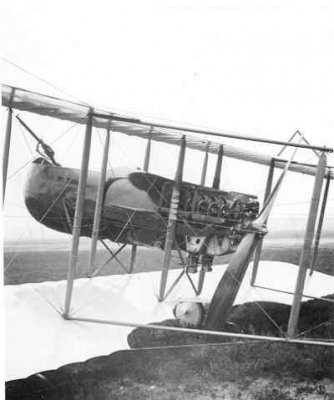
[Enclosed photo from BeeldBank NIMH. Click on photo for ordering information]
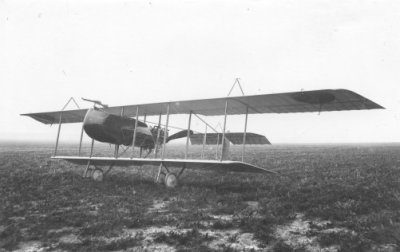
[Enclosed photo from BeeldBank NIMH. Click on photo for ordering information]
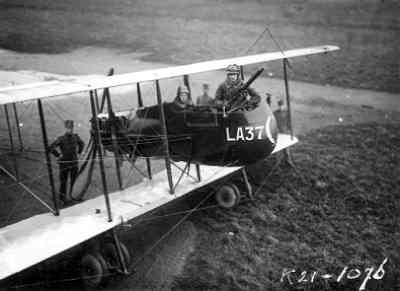
[Enclosed photo from BeeldBank NIMH. Click on photo for ordering information]

[Enclosed photo from BeeldBank NIMH. Click on photo for ordering information]
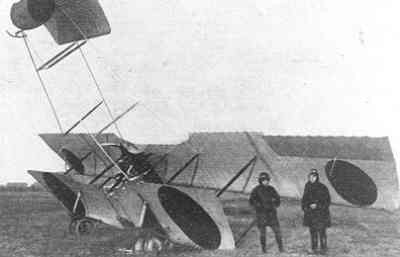
[Enclosed photo from BeeldBank NIMH. Click on photo for ordering information]
| Serial | 2nd Serial | 3rd Serial | Constr. nr. | Date in service | Date out of service | Notes |
|---|---|---|---|---|---|---|
| LA37 | MF901 | MF801 | 10-11-1916 | 1920 | Farman MF-40; Detained Belgian aircraft. Was F-901. During 1918 re-serialled MF901, later again re-serialled in MF801. Together with remaining interned aircraft written off in 1920. |
1/72nd Scale
Kits
- --
- Kit --: ---
Modelling add-on
- --
- Set --: --
Decals
- --
- Set --: --
1/48th Scale
Kits
- --
- Kit --: --
Modelling add-on
- --
- Set --: --
Decals
- --
- Set --: --
| Scheme | Colour name | Humbrol | XtraColor | Vallejo Model Color | Vallejo Model Air | |
|---|---|---|---|---|---|---|
| Standard #1 | Linen parts | Clear dope | 41 | 70.918 | ||
| Wooden parts | Varnish | |||||
| Fuselage | Dark grey | 32 ? | 70.866 | 71.052 | ||
Check www.paint4models.com for an extensive conversion table with lots of colour and paint systems.
Literature.
| AVIA: 34e jaargang nummer 3: Vliegtuiginformatie: Farman HF-22 | Thijs Postma & F. Zandvliet | Pag. 92 - 96 | 1975 | Uitgevers Wyt, Rotterdam |
| AVIA: 34e jaargang nummer 6: Lezers schrijven: Farman - 2 | Harm J. Hazewinkel | Pag. 209 | 1975 | Uitgevers Wyt, Rotterdam |
| AVIA: 34e jaargang nummer 6: Lezers schrijven: Farman - 1 | Frits Gerdessen | Pag. 208 | 1975 | Uitgevers Wyt, Rotterdam |
| Nederlandse Militaire Luchtvaart in Beeld. deel 1. | Hugo Hooftman | Pag. 1; 6 - 8 | 1977 | Uitgever: Europese Bibliotheek, Zaltbommel |
| AviaHobby; eerste jaargang 1980: De vliegtuigen van de Luchtvaartafdeling | F. Gerdessen | 1980 | Uitgevers Wyt, Rotterdam | |
| Van Luchtvaartafdeling tot Koninklijke Luchtmacht 75 jaar Militaire Luchtvaart in Nederland | Koos van de Berg | Pag. 6 | 1987 | Uitgever: Rebo Produkties, Sassenheim |
| KLu Vliegtuigen: De vliegtuigen van de Koninklijke Luchtmacht vanaf 1913 | Wim Schoenmaker & Thijs Postma | Pag. 9 | 1987 | Uitgeverij De Alk, Alkmaar |
| Nederlandse Militaire Luchtvaart V Farman HF-20/HF-22/F-40 | Harm J. Hazewinkel | Pag. | 1990 | Uitgever: St. Vrienden v.h. Mil. Luchtv. Museum, Soesterberg |
| Squadrons van de Koninklijke Luchtmacht (derde herzien druk) | Willem Helfferich | Pag. 11 - 13 | 1994 | Uitgevers Wyt, Rotterdam |
| Camouflage en Kentekens | J.Greuter e.a. | 1997 | Bonneville – Bergen (NH) |
Websites.
--
- Details
- Hits: 10447
History
The Farman factory was founded at about 1908. The two brothers Henry and Maurice Farman showed three aircraft, designed by Henry Farman, at several air shows in August 1919.
In 1914 the factory employed about 600 employees.
Due to personal problems both brothers had their own, strictly segregated design bureaus.
The aircraft, designed before World war I by Henry Farman, showed a great resemblance.
All types were of the pusher type with a rotating engine, a wingspan of the lower wing being half of the wingspan of the upper wing, a open fuselage for the crew and two tail booms..
Main differences were wingspan an engine type.
The Farman HF-20 had a wingspan of 13,5 m and had also skates between the wheels.
The Farman HF-22 showed a great resemblance with the HF-22, but had a larger wingspan of 15,58 m and lacked both skates.
| Dimensions: | |||
| Lenght: | 8,26 m | Wingspan: | 13,5 m |
| Height: | 3,2 m | Wing area: | 35 m2 |
| Weights: | |||
| Empty weight: | 365 kg | Max. start weight: | 640 kg |
| Performance: | |||
| Cruising speed: | - km/hr | Max. speed: | 110 km/hr |
| Climping speed: | - m/min | ||
| Service ceiling: | 315 m | Range: | 250 km |
| Miscellaneous: | |||
| Crew: | TWo men: one aviator plus one observer | ||
| Engine type: | Eén Gnôme Lambda van 80 pk. | ||
| Armament: | one machine gun | ||
| Dimensions: | |||
| Lenght: | 8,8 m | Wingspan: | 15,58 m |
| Height: | 3,2 m | Wing area: | 46 m2 |
| Weights: | |||
| Empty weight: | 385 kg | Max. start weight: | 710 kg |
| Performance: | |||
| Cruising speed: | km/hr | Max. speed: | 105 km/hr |
| Climping speed: | - m/min | ||
| Service ceiling: | - m | Range: | 300 km |
| Miscellaneous: | |||
| Crew: | Two men: one aviator plus one observer | ||
| Engine type: | One Gnôme rated 80 hp. | ||
| Armament: | |||
In service with LVA; RNLNAS and NEIAF.
In service with LVA.
In May 1913 Captain Walaardt Sacre, Lieutenant Van Heyst and ir Roozendaal visited in France several aircraft factories in search of equipment for the Aviation Department (Luchtvaart Afdeeling) of the Dutch Army (known as LVA) , which had to be established.
After evaluating products from Farman, Caudron and Bleriot, the Farman HF-20 was selected.
Three aircraft of this type were bought and delivered in September 1913 with the registration LA2 through LA4.
The Farmans were all used for training purposes.
The LA2 crashed on September 27, 1915, killing both pilots Lt Hofstee and Lt. Polis. On June 26 the LA3 crashed at Soesterberg, the lt Schlimmer was badly wounded, the mechanic Corporal Van de Wal, was only slightly injured.
The remaining LA4 was re-serialled HF26 early 1918 and went out of service mid-1919.
Early 1914, six aircraft of a larger, improved version, the Farman HF-22 were ordered. Due to the outbreak of war, just four examples were delivered.
Three of them received the LVA serials LA6 to LA8. The fourth went to the Navy with the registration M1. Oddly enough, two sets had an 60 hp engine, the other two had a 80 hp engine. The engine of 60 horsepower was soon replaced by a 80 hp engine.
The Naval Farman M.1 was already on 25 May 1915 transferred to the LVA, where the registration was LA9.
Aircraft Factory NV Nederlandsche Trompenburg, owned by Henri Wijnmalen, was requested to built new aircraft as Wijnmalen had obtained the licensing rights for Farman.
On June 22, 1915 was the first Trompenburg-Farman HF22, serialled LA10 was delivered. The last Trompenburg-Farman, serialled LA27 was delivered on April 26, 1916. Trompenburg built eleven aircraft for the LVA, ie LA10, LA11, LA15 t/m LA21 and LA26 and LA27, and three pieces for the Navy.
Early 1918, the remaining Farmans were reserialled with new registrations HF10 to HF20. Crashed aircraft were used by the technical department of the LVA, to build two new aircraft, LA30 and LA32, later serialled HF15.
At the end of 1918, all remaining Farman were decommissioned and sold.
Over time, the Gnome engines replaced by Swedish Thulin A 80-100 hp engines.
In service with RNLNAS.
The first aircraft of the Dutch Navy, a Farman HF-22, entered service on July 28, 1914 with serial MA1.
It was used intensively at Soesterberg as a trainer, so after one year a complete overhaul was necessary. It was handed over to the LVA, which gave it the new serial LA9.
At the end of July 1915 a second Farman, with serial M1 was received, soon followed by five other aircraft. These were built under license at the Trompenburg aircraft factory at Amsterdam. The Farmans received new serials in 1917, A1 till A6.
In October 1918 the Farmans were transferred to the new Naval Air Station "De Kooy" and kept in service as trainers till mid 1919.
In service with NEIAF.
Serial overview LVA; RNLNAS and NEIAF.
Serial overview NEIAF
| Serial | 2nd Serial | Constr. nr. | Date in service | Date out of service | Notes |
|---|---|---|---|---|---|
| De Brouckére reconnaissance aircraft,an improved Farman HF-20/22, which had a strong resemblance with the original aircraft. | |||||
| K1 | 07-1914 | 02-12-1914 | Used in the Netherlands for training purposes. | ||
| K2 | 25-07-1914 | 1915 | Used in the Netherlands for training purposes. | ||
| Farman HF-20 | |||||
| K3 | 06-1913 | 1916 | Used in the Netherlands for training purposes. In 1916 to LVA as LA21 (II) | ||
| K4 | 1916 | 17-11-1917 | Used in the Netherlands for training purposes. To LVA as possibly LA21; Collision with Albatros B.II LA39 and wrecked; written off. |
||
Serial overview LVA.
| Serial
Serial
|
2e Serial
2e Serial
|
Constr. nr.
Constr. nr.
|
Date in service
Date in service
|
Date out of service
Date out of service
|
Notes
Notes
|
|---|---|---|---|---|---|
| The serials of the LVA used in combination with a letter, didn't have a hyphen. e.g : LA34, D405. Relation between the LA-serials and the new serials is not known in case it concerns more aircraft of one type. The regulations are lost. |
|||||
| Farman HF-20 | |||||
| LA2 | 03-10-1913 | 27-09-1915 | Fallen down and wrecked; Written off | ||
| LA3 | 04-10-1913 | 26-07-1917 | Farman HF-20; Fallen down and wrecked; Written off | ||
| LA4 | 08-10-1913 | 01-11-1919 | 07-05-1918 emergency landing and wrecked; Written off 01-01-1919 | ||
| LA6 | 28-07-1914 | 28-01-1916 | Fallen down and wrecked; Written off | ||
| LA26 | HF19 | 16-03-1916 | 11-1918 | Collided over Soesterberg with Caudron V427; Written off. | |
| Farman HF-22 | |||||
| LA7 | HF10 | 02-08-1914 | 11-1919 | Written off | |
| LA8 | 02-08-1914 | 17-08-1916 | Written off | ||
| LA9 | HF11 | 28-05-1915 | 11-1919 | Written off | |
| LA10 | HF12 | 05-06-1915 | 11-1919 | Written off | |
| LA11 | HF13 | 23-08-1915 | 11-1919 | Written off | |
| LA15 | HF14 | 10-1915 | 11-1919 | Written off | |
| LA16 | HF15 | 31-10-1915 | 11-1919 | Written off | |
| LA17 | 29-11-1915 | 11-1919 | Written off | ||
| LA18 | HF16 | 17-12-1915 | 06-1916 | Involved in a collision and written off. | |
| LA19 | 29-12-1915 | 24-10-1916 | Crashed and written off. | ||
| LA20 | HF17 | 28-01-1916 | 11-1919 | Written off | |
| LA21 | 18-02-1916 | Probably delivered to NEIAF as K-4 | |||
| LA21 | HF18 | 1916 | 11-1919 | Possibly ex-K3, NEIAF | |
| LA27 | HF20 | 25-04-1916 | 11-1919 | Written off | |
| LA30 | 1916 | 28-07-1916 | LVA built. Wrecked in landing and written off. | ||
| LA32 | HF25 | 28-07-1916 | LVA built; Written off | ||
Serial overview RNlNAS.
| Serial
Serial
|
2e Serial
2e Serial
|
3e Serial
3e Serial
|
Constr. nr.
Constr. nr.
|
Date in service
Date in service
|
Date out of service
Date out of service
|
Notes
Notes
|
|---|---|---|---|---|---|---|
| MA-1 | 28-07-1914 | 28-05-1915 | Farman HF-22; Went to LVA as LA9. | |||
| M-1 | M.A.1 | A-1 | 30-07-1915 | 14-03-1919 | Accident at Naval Air station De Kooy; Written off. | |
| M-2 | M.A.2 | A-2 | 16-10-1915 | 31-03-1919 | Written off | |
| M-3 | M.A.3 | A-3 | 1916 | 15-11-1917 | Entered service 1916; Crashlanding at Soesterberg and written off. | |
| A-4 | 28-11-1917 | 17-02-1922 | Written off | |||
| A-5 | 6-12-1917 | 09-03-1920 | Written off | |||
| A-6 | 16-12-1917 | 31-03-1919 | Written off |
1/72nd Scale
Kits
- Luedemann
- Kit L4001: a resin kit of Farman HF20/22/23
- Omega
- Kit PR72271: Farman HF20 (LVA) (Dutch AF, Belgian AF).
- Kit PR72048; a resin model of Farman HF22
- Kit PR72047; a resin model of Farman HF20
- Skuld
- Kit XX: a vacu formed model of Farman MF-20/HF-23
Modelling add-on
- --
- Set --: --
Decals
- --
- Set --: --
1/48th Scale
Kits
- --
- Kit --:--
Modelling add-on
- --
- Set --: --
Decals
- --
- Set --: --
| Scheme | Colour name | FS-number | BS-number | Humbrol | XtraColor | Vallejo Model Color | Vallejo Model Air | |
|---|---|---|---|---|---|---|---|---|
| Standard #1 | Linen parts | Clear dope | 41 | 70.918 | ||||
| Wooden parts | Varnish | |||||||
| Fuselage | White | 34 | 70.951 | 71.001 | ||||
Check www.paint4models.com for an extensive conversion table with lots of colour and paint systems.
Literature.
| AVIA: 34e jaargang nummer 3: Vliegtuiginformatie: Farman HF-22 | Thijs Postma & F. Zandvliet | Pag. 92 - 96 | 1975 | Uitgevers Wyt, Rotterdam |
| AVIA: 34e jaargang nummer 6: Lezers schrijven: Farman - 2 | Harm J. Hazewinkel | Pag. 209 | 1975 | Uitgevers Wyt, Rotterdam |
| AVIA: 34e jaargang nummer 6: Lezers schrijven: Farman - 1 | Frits Gerdessen | Pag. 208 | 1975 | Uitgevers Wyt, Rotterdam |
| Zestig jaar Marineluchtvaartdienst in Beeld. | Hugo Hooftman | Pag. 1 - 2 | 1977 | Uitgever: Europese Bibliotheek, Zaltbommel |
| Nederlandse Militaire Luchtvaart in Beeld. deel 1. | Hugo Hooftman | Pag. 1; 6 - 8 | 1977 | Uitgever: Europese Bibliotheek, Zaltbommel |
| Militaire Luchtvaart in Nederlandsch-Indië in beeld. Deel 1 | Hugo Hooftman | Pag. 3 | 1978 | Uitgever: Europese Bibliotheek, Zaltbommel |
| Nederlandse Marinevliegtuigen | Thijs Postma & Nico Geldhof | Pag. 6 | 1978 | Uitgever: Omniboek, 's Gravenhage |
| AviaHobby; eerste jaargang 1980: De vliegtuigen van de Luchtvaartafdeling | F. Gerdessen | 1980 | Uitgevers Wyt, Rotterdam | |
| Nederlandse vliegtuigen naar buitenlands ontwerp | Theo Wesselink & Thijs Postma | Pag. 17 - 20 | 1984 | Uitgever: Romen Luchtvaart, Haarlem |
| 40 Jaar luchtvaart in Indië | Gerard Casius & Thijs Postma | Pag. 19 | 1986 | Uitgeverij De Alk, Alkmaar |
| Van Luchtvaartafdeling tot Koninklijke Luchtmacht 75 jaar Militaire Luchtvaart in Nederland | Koos van de Berg | Pag. 6 | 1987 | Uitgever: Rebo Produkties, Sassenheim |
| KLu Vliegtuigen: De vliegtuigen van de Koninklijke Luchtmacht vanaf 1913 | Wim Schoenmaker & Thijs Postma | Pag. 9 | 1987 | Uitgeverij De Alk, Alkmaar |
| 70 Jaar Marine-LuchtvaartDienst | Nico Geldhof | Pag. 11 | 1987 | Uitgeverij Eisma b.v., Leeuwarden |
| Vliegen voor de Vloot; 70 jaar Marineluchtvaartdienst | Harm J. Hazewinkel | Pag. 4 - 6 | 1987 | Uitgever: Rebo Produkties, Sassenheim |
| Nederlandse Militaire Luchtvaart V Farman HF-20/HF-22/F-40 | Harm J. Hazewinkel | Pag. | 1990 | Uitgever: St. Vrienden v.h. Mil. Luchtv. Museum, Soesterberg |
| Squadrons van de Koninklijke Luchtmacht (derde herzien druk) | Willem Helfferich | Pag. 11 - 13 | 1994 | Uitgevers Wyt, Rotterdam |
| Camouflage en Kentekens | J.Greuter e.a. | 1997 | Bonneville – Bergen (NH) | |
| 85 Jaar Marineluchtvaartdienst in beeld Van Farman tot NH 90 Helikopter | Peter Korbee | Pag. 8 - 9 | 2002 | Uitgever: Korbee MLD Promotie, Valkenburg |
Websites.
- Details
- Hits: 14615
History
Text about the development.
Versions.
Text about version.
| Dimensions: | |||
| Length: | 7,7 m | Wingspan: | 10,5 m |
| Height: | 3,55 m | Wing area: | 14 m2 |
| Weights: | |||
| Empty weight: | 695 kg | Max. start weight: | 995 kg |
| Performances: | |||
| Max. speed: | 278 km/hr | Climbing speed: | - m/min |
| Cruising speed: | - km/hr | ||
| Range: | 400 km | Service ceiling: | 6200 m |
| Miscellaneous: | |||
| Engine type: | One 240 hp Argus 10C. | ||
| Crew: | One aviator | ||
| Armament: | None | ||
The aircraft was left behind by the Germans at air base Twenthe. It was in good condition and mainly used for aerobatics by capt. Sipkes.
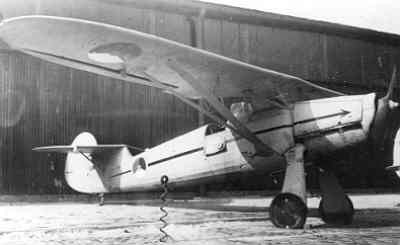
[Ingesloten foto van BeeldBank NIMH. Klik op de foto voor bestel-informatie]
Focke-Wulf FW-56 Stösser
| Serial | Construction nr. | Date in service | Date out of service | Notes |
|---|---|---|---|---|
| LSK-111 |
1/72nd Scale
Kits
- Heller
- Kit XX: A injection moulded kit.
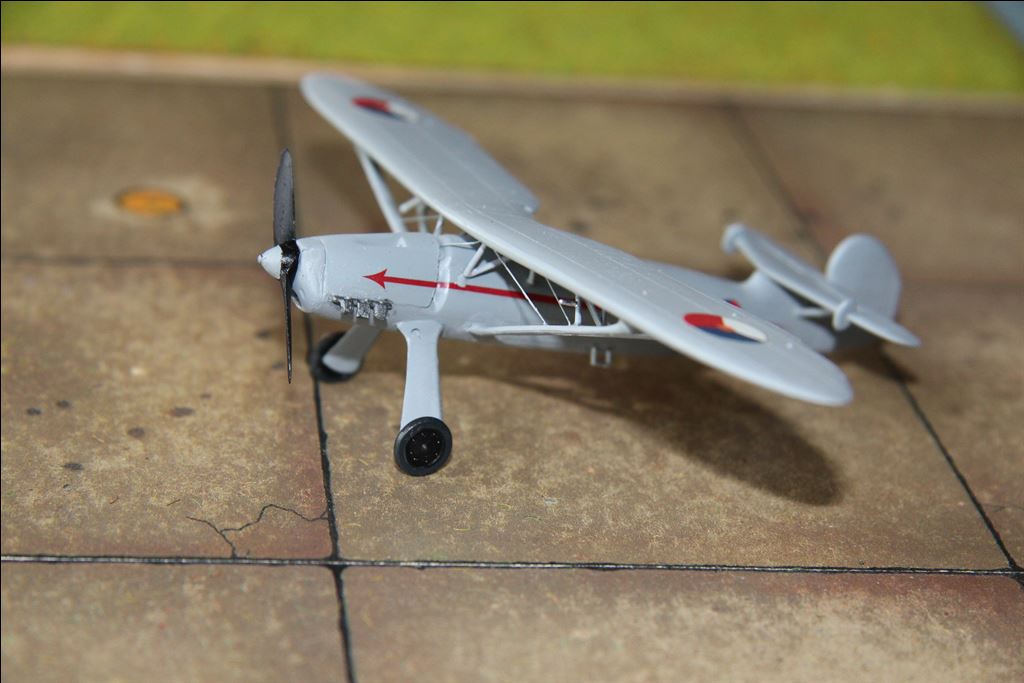
A model of the Focke-Wulf FW-56 Stösser, built summer 2015. The kis used is the old Heller kit in 1.72nd scale; decals originate from Dutch Decal set 72052
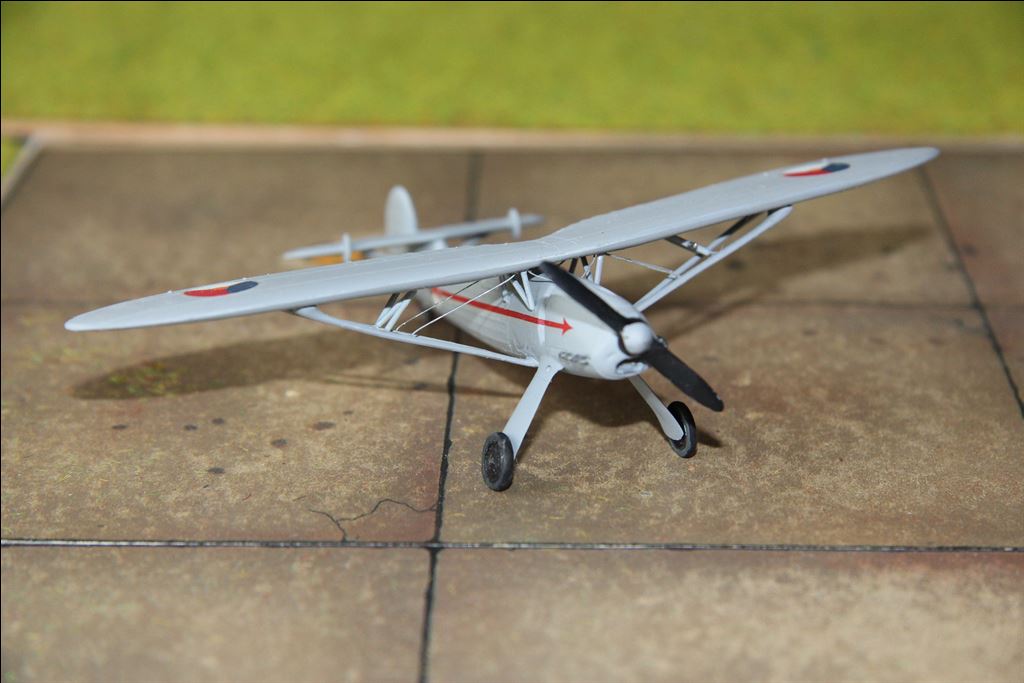
Modelling add-on
- Falcon
- Set VAX 28: Luftwaffe part 5: Canopies for BF109F/G, Hs129, Me262A, HS123, Fw56, Ju88,...
Decals
- Dutch Decal
- Set 72052: Decalset for Curtiss H-75A-7 Hawk (two versions); Lockheed 212 (one version); Focke-Wulf FW-56 Stösser LSK-111 and North American NA-27 997.
1/48th Scale
Kits
- HaPM Ltd
- Kit 48-011 : Injection moulded kit of Focke Wulf FW56 Stösser
Modelling add-on
- --
- Set --: --/li>
Decals
- Dutch Decal
- -
- Set 48042: Decalset Sea Hawk Kon Marine, Hunter KLu, Swordfish FAA, and FW56 Stosser LSK).
The aircraft was painted in overall grey, RLM 63, it carried a red arrow on both sides of the fuselage.
| Scheme | Colour name | RLM-nr | FS number | Humbrol | XtraColor | Revell | Vallejo Model Color | Vallejo Model Air | |
|---|---|---|---|---|---|---|---|---|---|
| Standard #1 | Overall | Hell-grau | RLM 63 | 36275 | mix: 5*34 + 1*156 + 1*64 | X221 | 36176 (Aqua) 32176 (emamel) |
||
Check www.paint4models.com for an extensive conversion table with lots of colour and paint systems.
Literature.
| KLu Vliegtuigen: De vliegtuigen van de Koninklijke Luchtmacht vanaf 1913 | Wim Schoenmaker & Thijs Postma | Pag. 96 | 1987 | Uitgeverij De Alk, Alkmaar |
| AVIA: 34e jaargang nummer 12: Vliegtuig-Informatie: Nederlandse Focke-Wulfs | Thijs Postma & F. Zandvliet | Pag. 398 - 399 | 1975 | Uitgevers Wyt, Rotterdam |
Websites.
--
